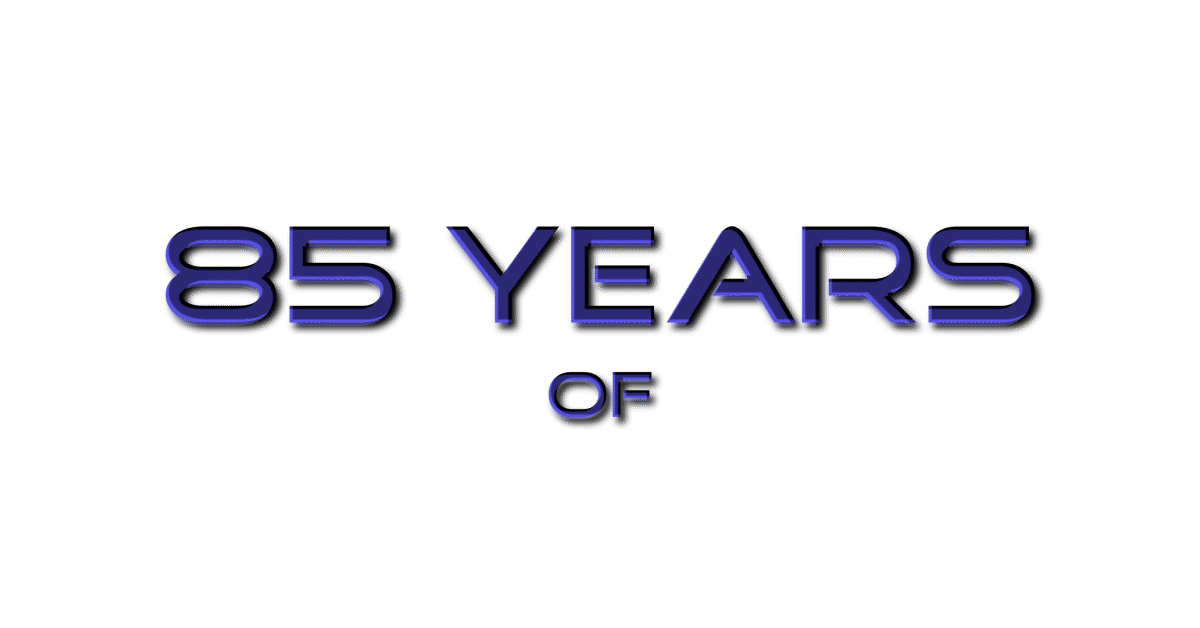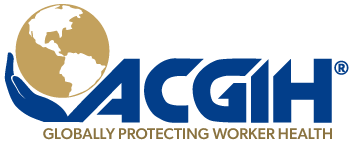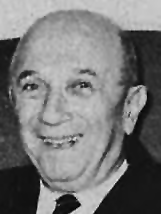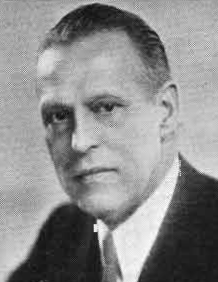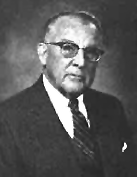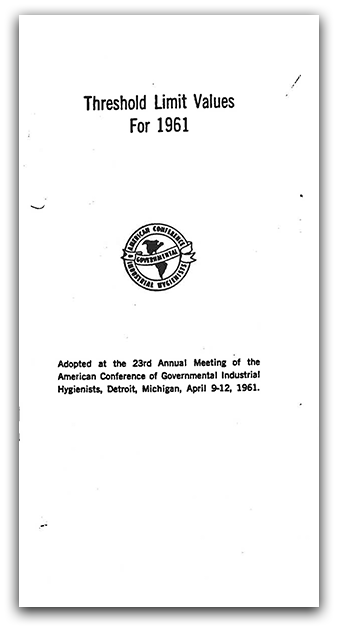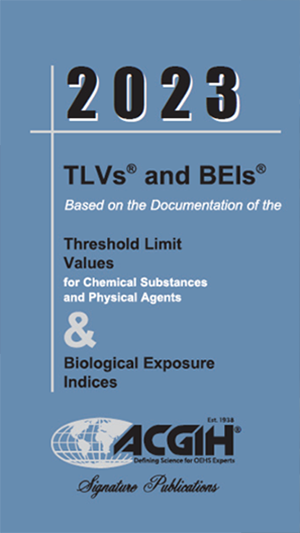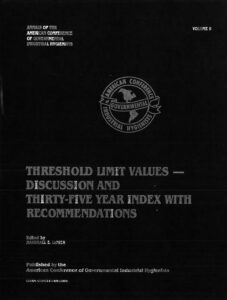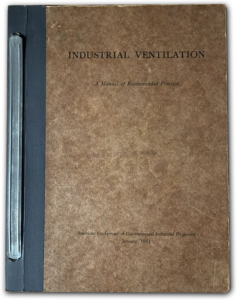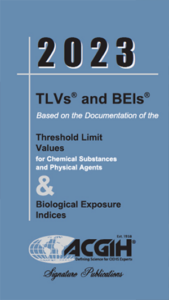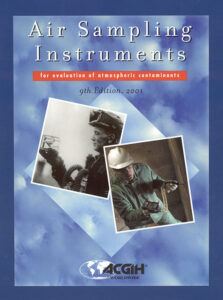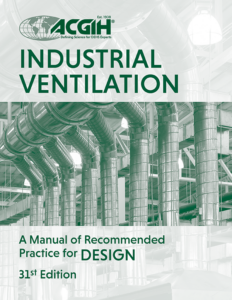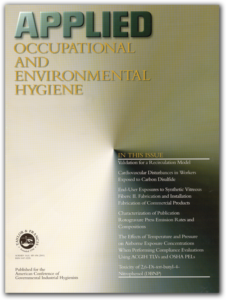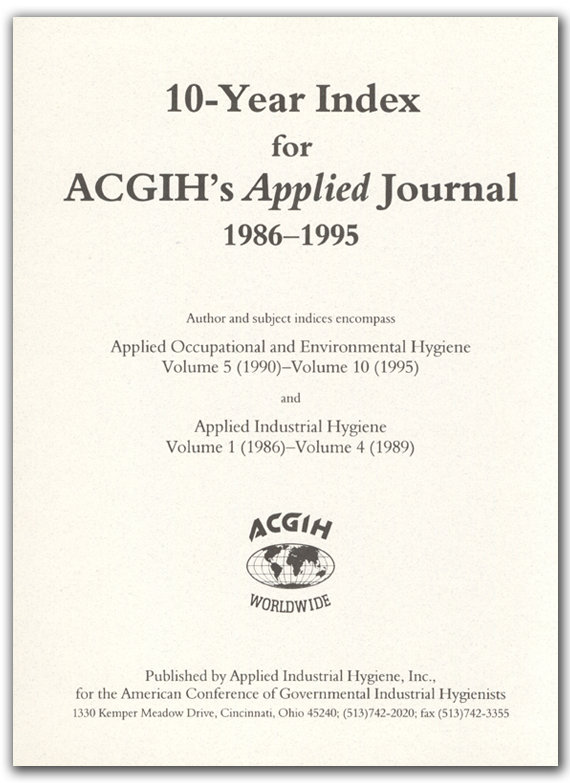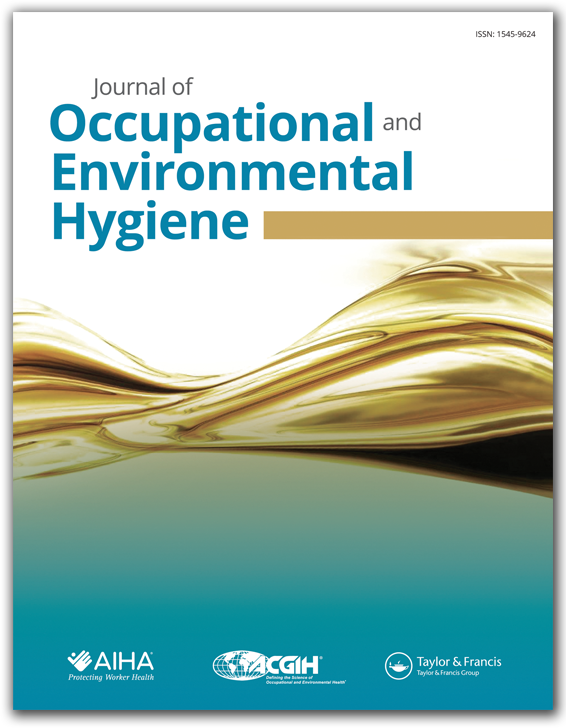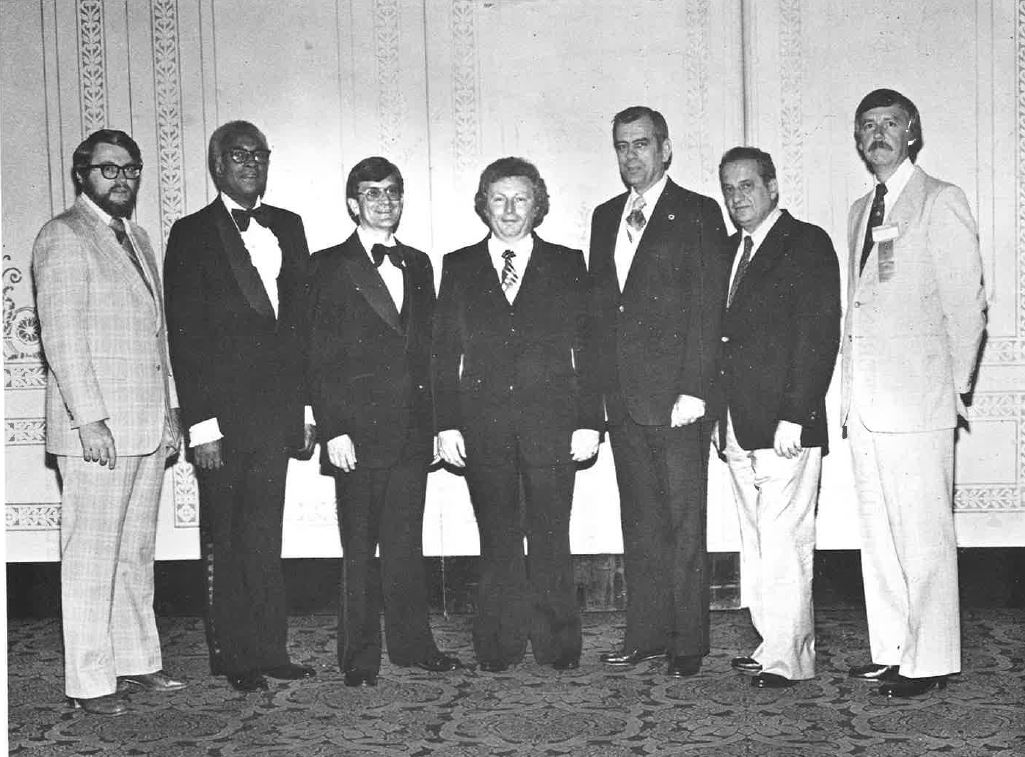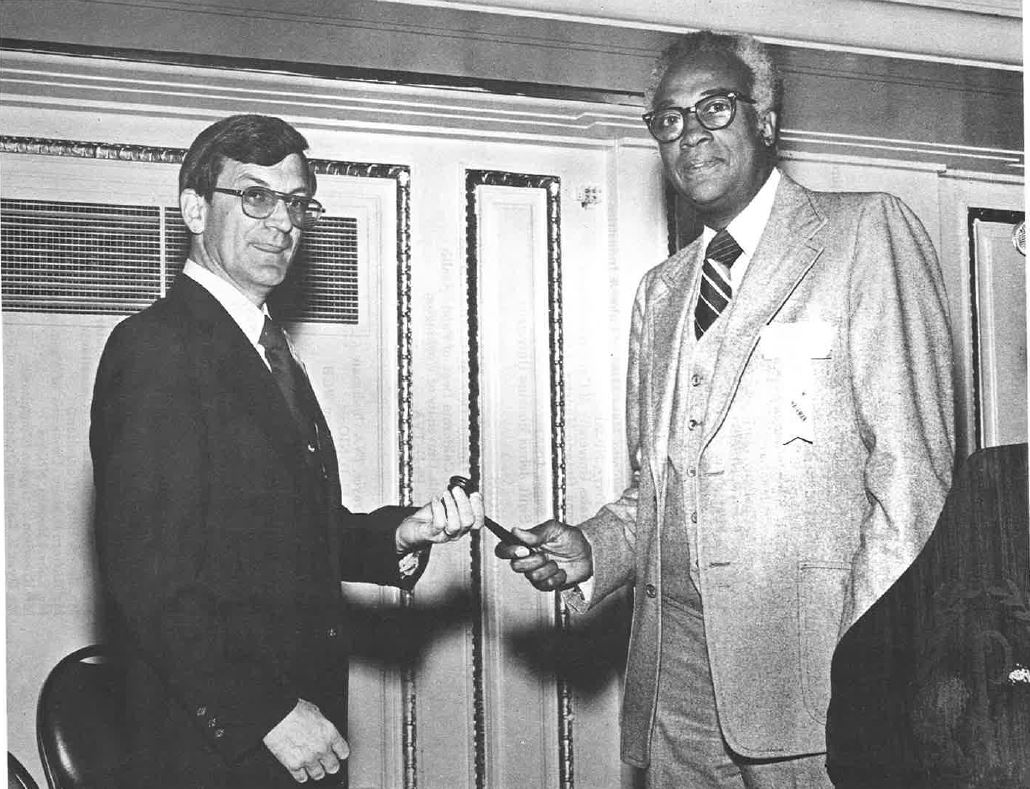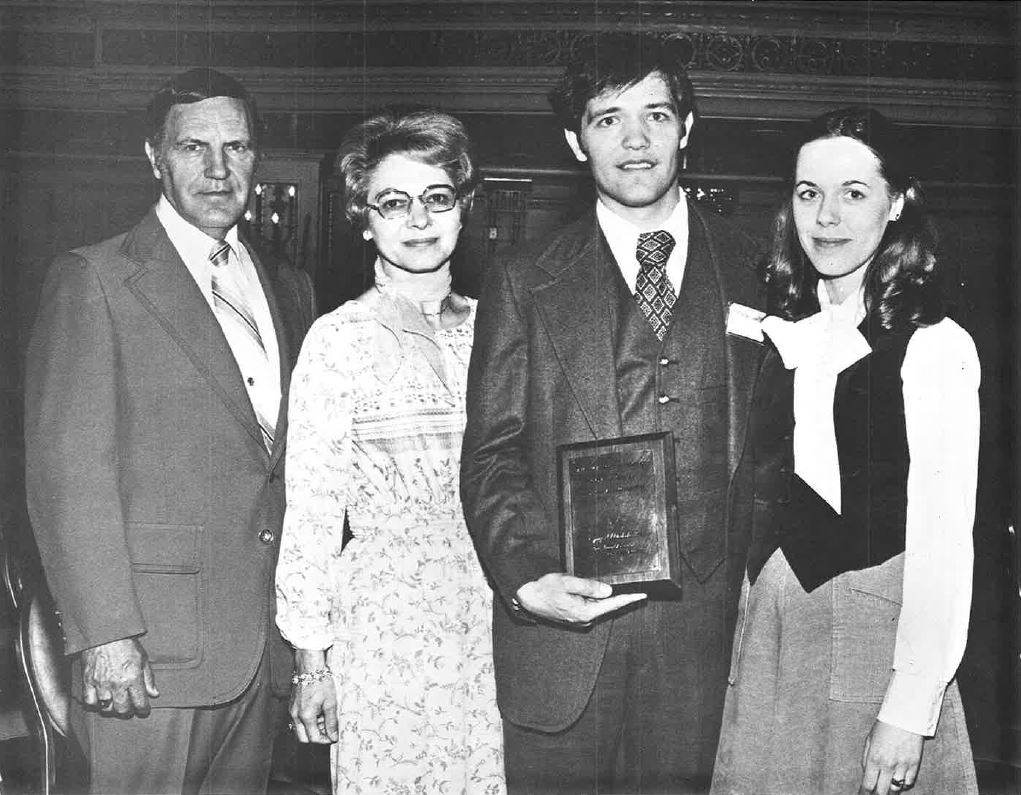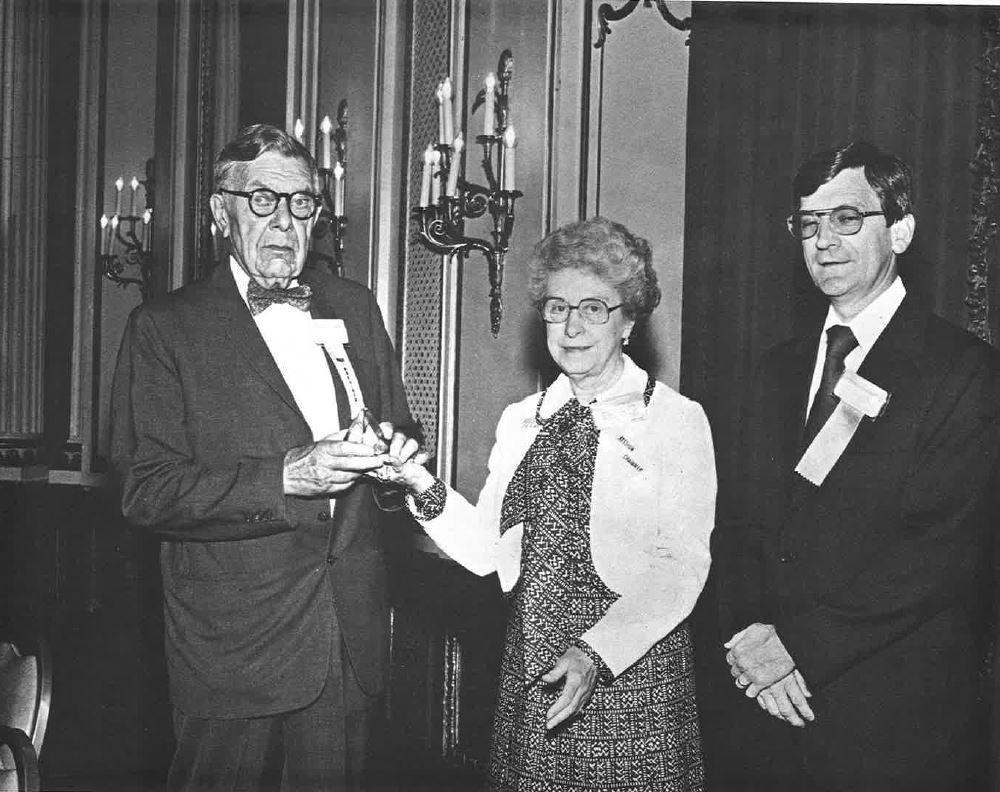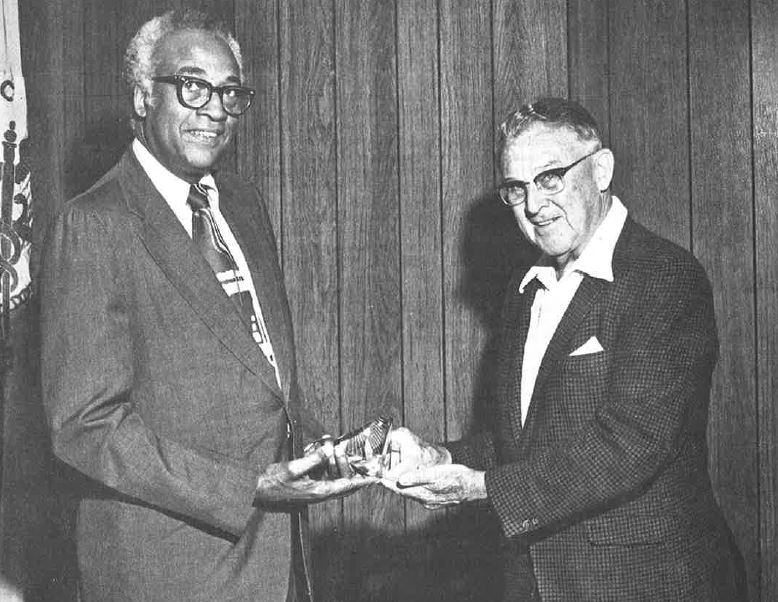For 85 years ACGIH has delivered protective resources for the OEHS professional. ACGIH is growing stronger to fulfill their needs and will continue to pursue new approaches and develop new scientific resources that will keep them safe and healthy while performing their jobs.
In 1938, a number of individuals engaged in industrial hygiene activities in government services formed the National Conference of Governmental Industrial Hygienists (NCGIH), later called American Conference of Governmental Industrial Hygienists (ACGIH). The objectives of the Conference were “to promote industrial hygiene in all its aspects and phases and to coordinate such activities in official governmental, state, local, and territorial organizations.” Over the years, ACGIH has devoted itself to administrative, technical and related aspects of worker health protection and to providing the exchange of ideas, information, and techniques for that end.
How We’ve Grown
- Opened our door to ‘all’ practitioners in the OEHS profession;
- Grown and diversified our membership;
- Gained more volunteers to provide their scientific knowledge in producing resources to keep us safe;
- Expanded our leadership to run our organization with expert guidance;
- Advanced our science to provide more accessible scientific data needed to protect the OEHS worker;
- Progressed in our education with an impressive increase in our educational opportunities;
- Produced scientific publications to give you accurate information to perform your job with confidence.
Over the years, ACGIH has both reflected and responded to the growing complexities of industrial processes and to new issues directly related to significant economic, social, and political changes. In retrospect, it is clear that ACGIH has contributed greatly to the profession of industrial hygiene and to the welfare of workers globally.
ACGIH HISTORY
Franklin D. Roosevelt’s New Deal
In October 1929 the stock market crashed. By 1932 one-quarter of the labor force was unemployed. Neither the federal, state, or local governments could provide adequate help. By the time Franklin D. Roosevelt took the oath of office, the depression had reached its lowest level. Roosevelt’s New Deal was a program designed to rescue the United States from the worst depression in its history. A guiding principle of New Deal legislation enacted in the 1930s was responsibility of government for human welfare. The Roosevelt administration set forth a program of reform and recovery. Its keynote was a new deal for the forgotten man. The New Deal would achieve a major change in the relationship of government to society. Within the first year of Roosevelt’s presidency, Congress had enacted far reaching social, labor, and economic legislation. Some of the laws directly affected working conditions, including safety and health. It is during this period that the genesis of the growing assumption of responsibility for health and safety of working men and women by the federal government appeared. The formation of the National Conference of Governmental Industrial Hygienists (NCGIH) in 1938 was a direct result of the new federal legislation. Jacqueline Karnell Corn, Protecting The Health of Workers: The American Conference of Governmental Industrial Hygienists 1938–1988, (American Conference of Governmental Industrial Hygienists, Inc., 1989), pp. 8-9.
First Transactions of the First Annual Conference
The independent National Conference of Governmental Industrial Hygienists (NCGIH) convened on June 27, 1938, in Washington, D.C. Representatives to the conference included 76 members, representing 24 states, three cities, one university, the U.S. Public Health Service, the U.S. Bureau of Mines, and the Tennessee Valley Authority. This meeting was the culmination of concerted efforts by John J. Bloomfield and Royd R. Sayers.
Click Here to view 1938 Transactions (Held in Washington, D.C. on June 27-29, 1938.)
1956 Transactions
A snip from the “Transactions of the EIGHTEENTH ANNUAL MEETING OF THE AMERICAN CONFERENCE OF GOVERNMENTAL INDUSTRIAL HYGIENISTS”. This meeting was held April 21-24, 1956 in Philadelphia, Pennsylvania.
One of the topics in the General Session, was from Lt. Col. Alvin F Meyer, Jr., PE, USAF (MSC) called “The Occupational Health Program of the Strategic Air Command.” In this article the question is asked, “Why have an occupational health program in a combat military organization such as SAC (Strategic Air Command)?” SAC is the long range nuclear striking force of the United States Air Force, a highly integrated organization of men and machines.
As the modern weapons system has become more and more effective, necessary support and maintenance for aircraft, accessories, armaments and weapons has also become increasingly complex.
A wide variety of industrial type operations are conducted within the shop and work areas involving many industrial hygiene and occupational health hazards and problems typical of the aviation industry. Because of the specialized nature of Air Force operations, there are a number of unusual type hazardous exposures. Among the problems of major concern in this area are those related to high intensity noise and the handling of large volumes of aviation fuel.
CLICK HERE for to read full article on pages 9-15 and for full 1956 transactions document.
Meyer, Lt. Col. Alvin F., Jr., PE, USAF (MSC). “The Occupational Health Program of the Strategic Air Command.” Transactions of the EIGHTEENTH ANNUAL MEETING OF THE AMERICAN CONFERENCE OF GOVERNMENTAL INDUSTRIAL HYGIENISTS. Philadelphia, PA: ACGIH, 1956. pp. 27-28.
Conference on Utilization of Industrial Hygiene
Personnel in Federal Agencies
In May 1943, NCGIH and AIHA both adopted resolutions to call upon the United States Navy, the United States Public Health Service, and the United States Maritime Commission to meet together to develop plans to effectively utilize existing industrial hygiene personnel and facilities. The four agencies met with representatives of NCGIH on July 7, 1943. Each of the representatives told of the severe shortage of industrial hygienists in their respective organizations. Discussion revealed that there were 330 industrial hygienists in the entire country, including those employed by states, universities, private industry, and insurance firms.
The worst shortages of industrial hygienists occurred in the state and local industrial hygiene units. The committee agreed that everything possible should be done to retain personnel in state and local areas. The outcome of the meeting was assurance to state and local industrial hygiene units that they could retain their numbers. The committee agreed upon a formula that allotted a certain number of engineers, based upon the size of the labor force in each state. For example, they allotted one industrial hygiene engineer to a state with a population of less than 500,000, two industrial hygiene engineers for a state with an industrial population over 500,000, and one more industrial hygiene engineer for each additional 500,000 workers. There were never enough industrial hygiene engineers during the war. This was merely a stop-gap measure.
The problems of scarce resources, including the work force, at a time when it was imperative to increase production, impacted upon health and safety during World War II. It stimulated the growth of industrial hygiene. Sadly, activity often took place for the wrong reasons, ones that most public health and industrial hygiene professionals would find unacceptable today. This increased interest and growth of the field of industrial hygiene all but disappeared after World War II. Lack of public interest and understanding led to retrenchment and a shrinking of the field.
During the war health and safety did not become institutionalized. It lacked both enforcement and concordance between those charged with production and those charged with health and safety and often amounted to little more than lip service or a slogan.
Jacqueline Karnell Corn, Protecting The Health of Workers: The American Conference of Governmental Industrial Hygienists 1938–1988, (American Conference of Governmental Industrial Hygienists, Inc., 1989), pp. 27-28.
John J. Bloomfield


On June 27, 1938 John J. Bloomfield combined his efforts with Royd R. Sayers to establish a meeting of the National Conference of Governmental Industrial Hygienists (NCGIH) in Washington, DC. Bloomfield was a US Public Health Service industrial hygienist, whose organization and leadership skills were instrumental to the founding of ACGIH.
One of America’s pioneers in industrial hygiene, Bloomfield’s outstanding research focused on hazards in the workplace. His studies were conducted in the actual work environments with personnel on-site rather than in laboratory experiments or with computer models.
Bloomfield, also known as “Black Jack,” served at the US Bureau of Mines, at the US Public Health Service, and in South America through the Institute of Inter-American Affairs and the Pan-American Health Organization. He was a charter member of both ACGIH and the American Industrial Hygiene Association (AIHA) and served both as Chair and President respectively.
In 1958, Bloomfield published an article in American Industrial Hygiene Association Journal “What the ACGIH has Done for Industrial Hygiene.” – Volume 19, Published 1 August 1958 – Issue 4.
Abstract: John J. Bloomfield, more familiarly known to industrial hygienists as “Jack”, was a pioneer in the development of industrial hygiene in the United States, and has been a leader and “sparkplug” in the field since those early days. He has transferred his pioneering and “sparkplugging” to South America, but continues to be a leader even here. This year, “Jack” was the recipient of the Cummings Memorial Award at the A.I.H.A. annual dinner. On the preceding evening, he was the honored guest and speaker at the Twentieth Anniversary Banquet of the American Conference of Governmental Industrial Hygienists. Your Editor and the Editorial Committee believe that the text of his talk at the A.C.G.I.H. dinner will be of interest and value to A.I.H.A. Journal readers for the historical background, and the ideas and concepts for the future. (Click Here to view entire article. John J. Bloomfield (1958) What the ACGIH has done for Industrial Hygiene, American Industrial Hygiene Association Journal, 19:4, 338-344, DOI: 10.1080/00028895809343600)
In 1979, the FIRST John J. Bloomfield Award was presented. This award is presented annually to a young industrial hygienist who has made significant contributions to the profession by pursuing occupational health hazards, primarily through fieldwork. The recipient must have at least three but less than ten years of experience in occupational health and must spend a minimum of 50 percent of his/her time conducting industrial hygiene studies and documenting the data involved. From 1978-1988, four women and six men have merited this award.
Read more about ACGIH Awards, previous recipients, and acceptance videos from current awardees.
Herbert E. Stokinger

The Herbert E. Stokinger Award recognizes outstanding contributions to the broad field of industrial toxicology. This award honors “Mr. TLV,” Herb Stokinger, who served as Chairman of the Threshold Limit Values Committee of ACGIH from 1961-1975. Dr. Stokinger received his education at Harvard and Columbia Universities and taught at the City College of New York, the University of Rochester, and Columbia University.
During his highly successful career, he researched the pharmacology and toxicology of atomic energy materials and gained respect for his research on the bateriological chemistry of gonococcus; toxins; and the chemotherapy of industrial, water, and air pollution toxicology. Dr. Stokinger received many awards and honors, including the Donald E. Cummings Award for outstanding contribution to knowledge and practice of industrial hygiene by the American Industrial Hygiene Association and the Award of Merit by the Society of Toxicology. Prior to his retirement, Dr. Stokinger was the Chief Toxicologist for the National Institute for Occupational Safety and Health.
The Conference
In 1943, the Annual Meeting took place as part of the Industrial Health Conference. NCGIH shared sponsorship with the American Industrial Hygiene Association (AIHA), the Industrial Medical Association, the American Association of Industrial Nurses, and the American Association of Industrial Dentists.
In 1960, members of ACGIH and AIHA cooperated to establish the American Board of Industrial Hygiene. Organized to improve the practice and educational standards of the profession of industrial hygiene, ABIH sponsors certification programs at the technologist and professional levels.
In 1961, the first American Industrial Hygiene Conference (AIHC) was cosponsored by ACGIH and AIHA. The Conference had just over 700 attendees (including exhibitors). ACGIH began co-sponsoring an annual conference with the American Industrial Hygiene Association (AIHA). The meeting program is designed to provide unparalleled opportunities for professional growth and development. Technical papers and informal roundtable discussions consider important topics of interest and application. Committee reports offer information updates on activities and achievements, while Business sessions conclude necessary operational matters. In addition, numerous exhibits offer displays of instruments/equipment, services, educational resources, and general technical information.
Today, the American Industrial Hygiene Conference and Exposition (AIHce EXP) is one of the world’s premier conferences for occupational and environmental safety and health professionals. It attracts an international attendance of more than 200 exhibitors and nearly 4,500 attendees each year.
TLVs and BEIs Book


In 1946, the FIRST Threshold Limit Values (TLVs) were adopted. This list included 146 TLVs. (Click Here to view Threshold Limits from 1946). The TLV Committee was formally established. This Committee has been a cornerstone of the ACGIH commitment to worker health and safety.
As the list expanded and its usage increased, it was decided to publish a pocket-sized booklet that was easy to carry and consult.
Over the next three decades, the TLV booklet continued to grow, reflecting the Committee’s mission to offer timely responses to changing needs. New sections or indicators have been included in the booklet as necessary.
In 1983, the TLV Committee recommended that a Committee on Biological Exposure Indices be established. This action recognizes the importance of assessment of overall exposures to chemicals in the workplace, in addition to assessment of inhalation exposures. The efforts of this committee were first reported in the 1984-85 TLV booklet. Biological Exposure Indices are now part of the annual publication.
Today, ACGIH has produced nearly 800 TLVs and BEIs and supporting scientific Documentations and distributed millions of copies of the book to industrial hygienists and other interested persons throughout the world.
ACGIH Annals Series
In 1981, recognizing the need for dissemination of even broader categories of information, ACGIH began publishing its series of Annals. This special series of publications covers Transactions of Annual Meetings, Proceedings of Symposia sponsored by ACGIH, and other topics of general information.

(“Annals of the American Conference of Governmental Industrial Hygienists”, Volume 9, “Threshold Limit Values – Discussion and Thirty-Five Year Index with Recommendations” – Published by ACGIH: 1984 – Click Here to see full publication.)
Membership
The independent National Conference of Governmental Industrial Hygienists (NCGIH) convened on June 27, 1938, in Washington, D.C. Representatives to the conference included 76 members, representing 24 states, three cities, one university, the U.S. Public Health Service, the U.S. Bureau of Mines, and the Tennessee Valley Authority. NCGIH originally limited its full membership to two representatives from each governmental industrial hygiene agency.
In 1946, the organization changed its name to the American Conference of Governmental Industrial Hygienists (ACGIH) and offered full membership to all industrial hygiene personnel within the agencies as well as to governmental industrial hygiene professionals in other countries.
Today, membership is open to all practitioners in industrial hygiene, occupational health, environmental health, and safety domestically and abroad. In January 2013, ACGIH members approved an amendment of the organization’s Bylaws, which created a single category of membership – a voting member – who must be employed at least 50% of his or her time in occupational or environmental health and safety.
Now with various categories of membership, ACGIH is able to include all types of workers and organizations in the occupational or environmental health and safety industry.
Education
In 1974, the FIRST ACGIH mid-year symposium was held on the topic of “Cotton Dust Health Problems, and Industrial Hygiene Techniques.“ This meeting brought together current research results and facilitated their dissemination.
Over the years ACGIH has supported numerous educational activities that facilitate the exchange of ideas, information, and techniques. These courses, symposia, webinars, and workshops are all vehicles for achieving the ultimate goal of worker health and safety. Topics have included cotton dust exposures, workplace control of carcinogens, industrial hygiene for mining and tunneling, asbestos identification and measurement, and others. Today, this commitment to providing forums for discussion of timely issues is evidenced through online learning and in-person courses on topics such as, bioaerosols, biomonitoring, chemical hazards, computational fluid dynamics, ergonomics, exposures, heat stress, hearing loss prevention, industrial ventilation, noise, safety, and more.
ACGIH is committed to providing its members and others in the occupational and environmental health industry with the information they need to excel in their profession.
Documentation
In 1950, ACGIH began to underwrite the publication of reports, documentations, and other materials germane to the field, because the Conference recognized the importance of disseminating technical information. This decision underscored the original mission of the Conference.
In 1962, ACGIH published the FIRST Documentation of TLVs. This has become a major reference for the profession.
Click Here to view 1962 Documentation on Benzene.
Today, all ACGIH Member Subscribers get mobile-friendly website access to the “gold standard” of globally recognized TLVs, BEIs, and all of their nearly 800 supporting scientific Documentations through Data Hub.

Click Here to Data Hub.
Board of Directors & Annual Meeting Locations
Then…
1938 Board of Directors — Washington, DC: Chairman: A.S. Gray, MD; Past Chairman: C.A. Nau, MD; Chairman-Elect: W.S. Johnson; Secretary-Treasurer: J.J. Bloomfield; Directors-at-Large: S.C. Rothmann, L.E. Judd, MD, M.H. Kronenberg
Now…
2023 Board of Directors — Phoenix, AZ: Chair: Jack Caravanos, DrPH, CIH; Treasurer: Lilia Chen, CIH, MS; Directors: Catherine A. Hovde, MS, CIH, CSP; COL(Ret.) Mary S. Lopez, PhD, CPE; John McKernan, ScD, CIH; Thomas M. Peters, MS, PhD, CIH; Pam Susi, MSPH, CIH; Edward T. Zellers, PhD; Neil J. Zimmerman, PhD, PE, CIH, FAIHA
Click Here for Past Board Members/Annual Meeting Locations from 1938-2022.
TLVs and TLVs Committees
From the beginning, the need for occupational exposure guidelines was a driving force behind the organization of governmental industrial hygienists. What began in 1941 as a Subcommittee of the Technical Standards Committee evolved into what is today the world-renowned Threshold Limit Values Committee of ACGIH charged with investigating and recommending occupational exposure guidelines, now called TLVs, for all occupational health professionals. Periodic review of the guidelines was an original intent of the Conference which persists today.
The distinguished history of the TLV Committee is characterized by timely response to changing needs. The original Time-Weighted-Average (TWA) guidelines were supplemented in the early 1960s with skin notations, ceiling limits, a listing of simple asphyxiants, and the first publication of TLV Documentations which provide professionals with the basis for the Committee’s recommendations.
In the late 1960s, growing social concern for legislating occupational exposure prompted the Committee to introduce a Notice of Intended Changes in its guidelines. This action identified those substances under active reconsideration and established a minimum two-year period for collection and analysis of additional data before a change could be formally adopted.
Also in the late 1960s, the first Physical Agent Threshold Limit Values for noise and lasers were published based on recommendations of the Physical Agents TLV Committee formed in 1966.
In the early 1970s, the Physical Agents TLV Committee established a TLV for microwave radiation.
Recognizing that not all chemical exposures persist throughout the workday, the TLV Committee introduced the Short-Term Exposure Limit (STEL) in the mid 1970s.
In the 1980s, the Committee refined its recommendations on the classification and control of exposure to carcinogens. Guidelines were formulated on Biological Exposure Indices, established in 1982, at the recommendation of the TLV Committee.
The strength of the TLV Committee comes from the consistently unselfish dedication and persistence of its volunteer membership. Voting members of the Committee are assisted by consultants from both industry and labor in the collection of occupational exposure data for analysis. The Committee now publishes a listing of Chemical Substances Under Study as a further method of soliciting exposure data from the world’s occupational health community to assist in their task of providing the strongest objective analysis as a basis for their recommendations on the more than 800 substances in the 2023 TLVs and BEIs Book.
Industrial Ventilation Manual

In 1951, the FIRST ACGIH Industrial Ventilation Manual was published. Control of occupational exposure through engineering methods was broadly recognized as a high priority, but in the early 1940s, little or no information was available for industrial hygienists as a guide to industrial ventilation design. To meet this need, ACGIH established the Industrial Ventilation Committee in 1944 and charged the members to prepare a guide on industrial ventilation design for practicing industrial hygienists.
Even before this charge, the Committee’s volunteer members on the industrial hygiene staff of the Michigan State Health Department had begun assembling data. With no funds available in 1951 when their first effort was complete, the Committee members personally funded the first printing. This first edition sold out immediately. A second printing was required to satisfy the demand for what quickly became the standard for industrial ventilation.
Committees
The hallmark of ACGIH is the productivity of its volunteer standing committees. From the beginning, the Conference functioned through its committees.
At its first meeting in 1938, NCGIH created nine standing Committees. The Committees were charged to address the important industrial hygiene issues of the pre-War era: appraisal methods; relationships with industry, labor, the medical profession and other agencies; technical standards; education; uniform reporting of occupational diseases and other illnesses among workers; administrative development of state activities; industrial health code; legislation; and personnel.
In 1941, a subcommittee of the Technical Standards Committee began to investigate and recommend threshold limits.
In 1944, NCGIH continued its work in establishing new environmental concepts in worker protection. A new Committee was formed to gather information and make recommendations on industrial ventilation.
In 1946, when the first TLVs were adopted, the TLV Committee was established. This Committee has been a cornerstone of the ACGIH commitment to worker health and safety.
In 1950, in response to the air pollution disaster at Donora, PA, ACGIH formed its Air Pollution Committee.
Over the next five decades, some of these Committees evolved and expanded, assuming different titles; some became the purview of other organizations or agencies; and some achieved their goals and ended their active roles. ACGIH’s Technical Committees have made significant contributions to the field of industrial hygiene. While each Committee has served an important purpose, three of them have made a lasting impact on our profession. The Threshold Limit Values, Industrial Ventilation, and Air Sampling Instruments Committees have achieved many firsts through their in-depth investigations, studies, and resulting publications.
These three publications are the most widely utilized emanated from these Committees: Threshold Limit Values and Biological Exposure Indices (TLVs and BEIs), Air Sampling Instruments, and Industrial Ventilation: A Manual of Recommended Practice for Design.



Today, there are five Scientific Committees concentrating on the essential topics of bioaerosols, biological exposure indices, industrial ventilation, threshold limit values for chemical substances, and threshold limit values for physical agents.
The tradition of reliable working Committees has served ACGIH exceptionally well. Through the efforts of its Committees, ACGIH has been able to provide critical information and has recommended practices to industrial hygienists worldwide. This history of sharing knowledge, based on careful study and independent judgment, has garnered international respect and accolades for ACGIH.
Click Here for ACGIH Scientific Committees.
Click Here to purchase the 2023 TLVs and BEIs Book.
Click Here to purchase the digital version or preorder print of the 31st Edition of Industrial Ventilation: A Manual of Recommended Practice for Design.
ACGIH’s Journal



In April 1986, ACGIH published its FIRST Professional Journal, Applied Industrial Hygiene (AIH). This publication blended peer-reviewed papers with editorial content. ACGIH’s journal was designed for the practicing professional.
In less than two years, in 1988, Applied Industrial Hygiene moved from a quarterly to monthly publication. It continued to feature quality papers that had been subject to careful, double blind peer review by members of the AIH Editorial Review Board. AIH also offered a variety of regular columns which highlighted areas of special interest and applications, news items, technical information, letters, and book reviews. In addition, special sections focused on topics of particular professional interest.
In 1990, the name changed to Applied Occupational and Environmental Hygiene (Applied) to reflect the scope and emphasis of the journal.
In 1996, ACGIH compiled the 10-Year Index for ACGIH’s Applied Journal 1986-1995 publication that encompassed all the issues of Applied Industrial Hygiene (1986-1989) and its successor, Applied Occupational and Environmental Hygiene (1990-1995).
In January 2004, Applied and the AIHA Journal combined to become the Journal of Occupational and Environmental Hygiene (JOEH), a new journal for the profession. JOEH, primarily an online journal, offers “fast-track” publishing of approved articles, and a continuous flow of important scientific information to the profession.
ACGIH’s continuing education program, The Action Level!, is included in the journal each month. The Action Level! is a convenient, cost-efficient program, through which Certified Associate Industrial Hygienists, Certified Industrial Hygienists and Certified Safety Professionals can maintain their certifications.
Faces from the Past
Taking you back to 1979, the “Transactions of the Forty First Annual Meeting of the American Conference of Governmental Industrial Hygienists”, which was held in Chicago, Illinois on May 27th, 1979, rekindles some faces of the past.

Board of Directors 1979-1980
Left to right: George Carson (Director), Marshall LaNier (Chair), David Trayer (Past Chairman), Bill Kelley (Executive Secretary), Charles Adkins (Chairman Elect), Jesse Lieberman (Director), Bobby Craft (Outgoing Past-Chairman); absent – Mary Louise Brown (Director), H. Grady Callison, Jr. (Vice Chairman-Elect), and Arthur Johnston (Secretary-Treasurer).

Marshall LaNier accepting gavel from outgoing Chairman David Trayer.

Mr. and Mrs. Wiederhoeft, Gary and Mrs. Wiederhoeft at presentation of FIRST John J. Bloomfield Award at business meeting.

Dr. Henry F. Smyth, Jr., Ph.D. accepting the Herbert E. Stokinger Award “Treton” from Mary Louise Brown, with Chairman David Trayer.

Chairman Marshall E. LaNier presented a “Treton” to Herbert E. Stokinger.
________________________________________
All images are from the Transactions of the Forty First Annual Meeting of the American Conference of Governmental Industrial Hygienists; Chicago (IL). Cincinnati (OH): ACGIH; c1979. p. 1-160.
